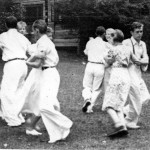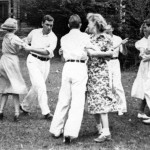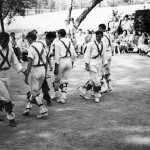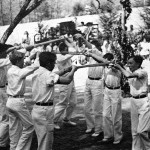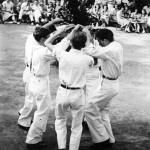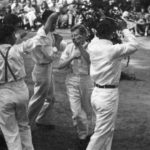Pine Mountain Settlement School
Series 09: BIOGRAPHY
William “Bill” Hayes, Student 1930s,
Farm Manager, 1937-1953, Trustee 1980s & 1990s
William Hayes (1914-2006)
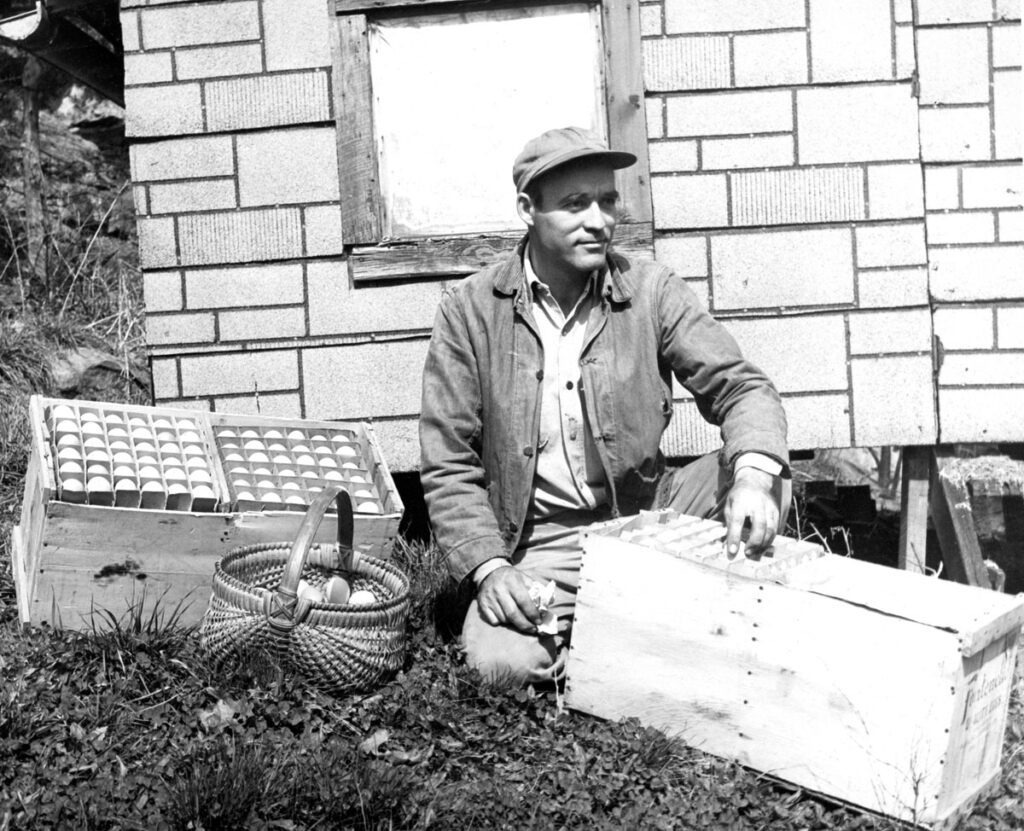
William Hayes with chicken house and eggs. 01b [64_life_work_general_farm_grounds_sorghum_001b -copy[
TAGS: William Hayes, Bill Hayes, Fern Hall Hayes, farm manager, Dr. Richard Drake, Berea College Service Award, Berea College, surface mining, SMCRA, Kentucky Division of Forestry, US Forest Service, Kentucky Department of Natural Resources, Daniel Boone National Forest, Red River Gorge, Little Shepherd Trail, Kentucky Guild of Artists and Craftsmen, forestry, Wilson Wyatt, Office of Surface Mining, US Department of the Interior, Lands Unsuitable for Mining, coal mining, coal camps, tuberculosis, Dr. Willis Weatherford, Howard Burdine, Kentucky Green Pastures Program, subsistence farming, Henrich van Loon
WILLIAM HAYES Student, Staff, Board (Part I)
Student, September 1934 – May 1938
Farm Manager, 1937 – 1953
Member, PMSS Board of Trustees, 1980s & 1990s
“Quality is never an accident: It is always the result of intelligent effort.”
William Hayes entered the high school at Pine Mountain in 1934. It was the beginning of a long education that would earn him both ovations and aggravations.
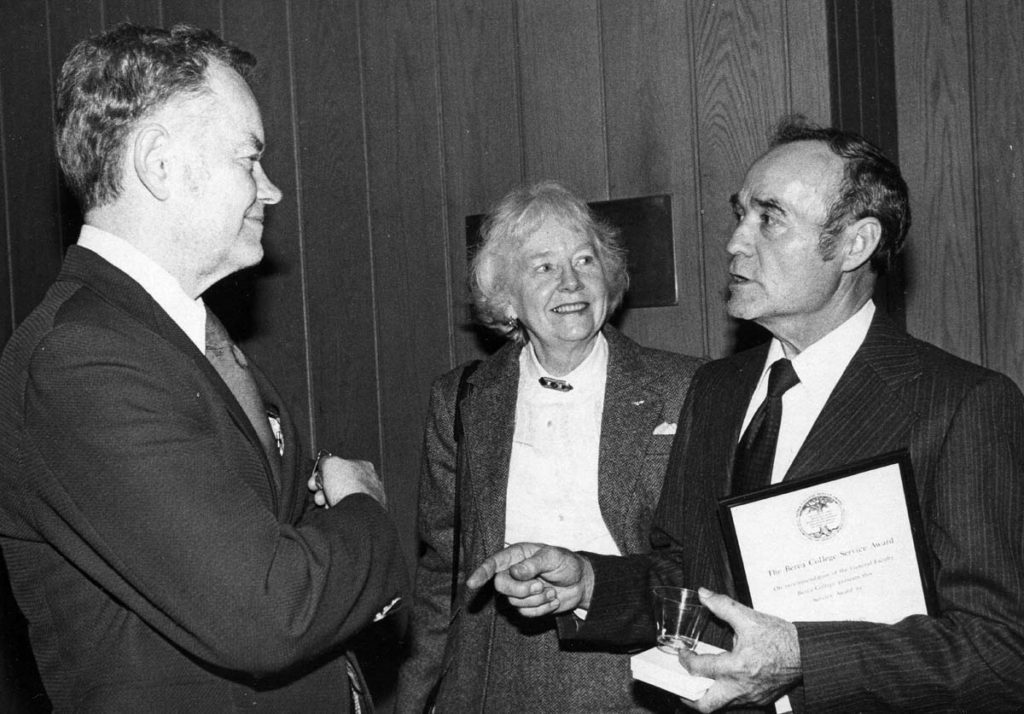
Dr. Richard Drake, Fern Hayes, and William Hayes at Berea Service Award ceremony, 1981. [hayes_berea_award2.jpg]
WILLIAM HAYES (Part I): Berea Service Award
The following introduction was written for William Hayes’ nomination for the Berea College Service Award in 1981. The award captures the high esteem his colleagues placed on him, the qualities that brought him ovations, and the circumstances that created aggravation. Those who understood Bill Hayes’ commitment to the environment and to the people of Eastern Kentucky, such as Berea College, often found themselves honored by his recognition, as their goals were often in line with his. The Berea College Service Award is given annually to individuals whose service exemplifies Berea’s Great Commitments.
THE RECOGNITION
William Hayes entered the high school at Pine Mountain Settlement School in 1934, and was placed in charge of the school’s farm during his junior year in 1937. On graduation, he continued in this position for seventeen more years during which time he managed a model dairy and poultry farm, raised a truck crop on 25 acres, introduced what has been termed a “revolutionary approach to cattle farming,” and became known widely as a teacher of conservation and care of the environment.
William Hayes’ abiding interest has been forestry, and while still Farm Manager for the Pine Mountain Settlement School, he joined with the Kentucky Division of Forestry, serving as Forest Ranger for Harlan County. In 1955, he became a full-time Forest Ranger, first for the Commonwealth of Kentucky, then for the U.S. Forest Service. In this capacity, he became particularly interested in strip mine reclamation, and in 1966 became Strip Mine Reclamation Supervisor for the Kentucky Department of Natural Resources.
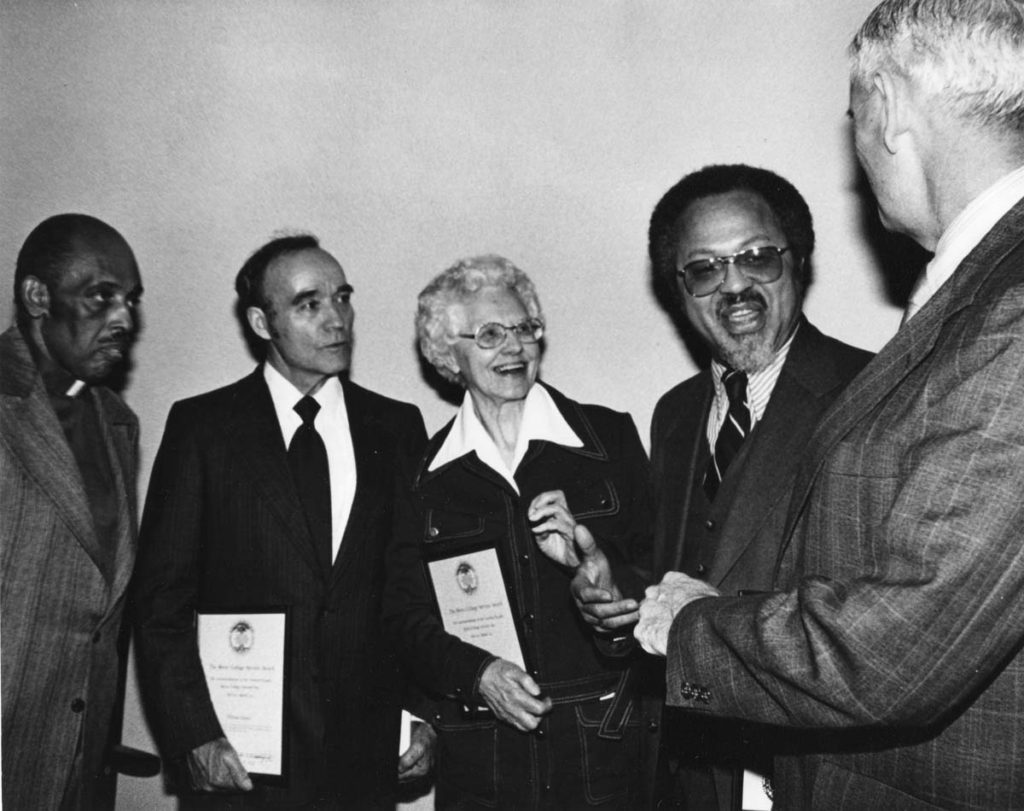
Father Henry Parker (Campus Minister), William Hayes (Recipient), Miss Alice Slone (Director of Lotts Creek Community School, Hazard, Recipient), Rev. J. Oscar McCloud (General Director, Program Agency United Presbyterian Church, NYC (Recipient), Dr. Willis Weatherford, (Berea College President). [hayes_berea_award.jpg]
For the past fifteen years, Mr. Hayes has been a bastion of strength and integrity at the heart of a regional and environmental problem of immense proportions. Again, first with Kentucky, then more recently with the U.S. Office of Surface Mining, he developed a reputation for honest enforcement and gained an abiding respect for his fairness from both sides of this tragically emotional issue. Call “a legend in his own time” and “The Godfather of Strip Mine Reclamation,” Mr. Hayes’ testimony before the Udall Committee on Interior and Insular Affairs, was very significant in shaping the Federal Surface Mining and Control Act of 1977. So important was his testimony that he was invited by President Carter to be present when the Act was signed, and the President called attention at that time to the importance of his testimony.
Berea College, because of its interest in the condition of the Appalachian environment and life, wishes to honor this son of Appalachia, a product of the Settlement School tradition, and a man who has demonstrated the highest integrity in an area where the temptation to be otherwise has abounded and honors herself by awarding William Hayes the Berea College Service Award.
Bill shared the award with two other recipients, seen above: Alice Slone, Founder of Lotts Creek Community School, at Cordia, near Hazard, Kentucky, and the Rev. J. Oscar McCloud, General Director of Program Agency United Presbyterian Church, NYC.
GALLERY: Berea Service Award
- 01 1981 Berea Service Award Ceremony,
- 02 1981 Berea Service Award Ceremony,
- 03 1981 Berea Service Award Ceremony,
- 04 1981 Berea Service Award Ceremony,
- 05 1981 Berea Service Award Ceremony,
- 06 1981 Berea Service Award Ceremony,
- 07 1981 Berea Service Award Ceremony,
- 08 1981 Berea Service Award Ceremony,
- 09 1981 Berea Service Award Ceremony,
WILLIAM HAYES (Part I): Coal Camps
At Pine Mountain Settlement School, the autobiography form designed by the Southern Women’s Educational Alliance and completed by each student applying for high school at Pine Mountain Settlement School and notes from family records, affords an introduction to the early life of William Hayes.
William [Bill] was born at Pine Knot, Kentucky, on September 3, 1914, to George and Daisy Stephens Hayes. Both the Hayes and Stephens families had lived in and around the Marsh Creek area near Pine Knot since the Revolutionary War. They made their early livings from farming and livestock trading. One of Bill’s early ancestors was a lawyer whose name appears on many documents in the county of Whitley (later McCreary County as the counties were subdivided).
Bill’s mother Daisy was a member of the large Stephens family at Pine Knot. They were a ridge-top farming family that settled in Whitley County following the Revolutionary War when land grants were issued for service in the war. Daisy could trace her roots back to Moses Stephens who came up to the Marsh Creek, Kentucky area just after the Revolutionary War from Asheville, North Carolina. He settled in on land granted as part of the land settlement afforded Revolutionary War soldiers for their service. Like many girls of the day, Daisy married at the early age of fifteen and quickly began a family. George, her husband was nineteen. Silven Hayes, the firstborn of the young couple, arrived just as Daisy turned sixteen and she rapidly had five more boys. Two boys died, including Bill’s twin, Bobby, who was stillborn, and a younger brother Raymond who succumbed to dysentery in the Kentucky coal camp of Coxton.
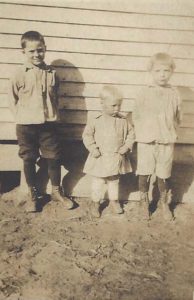
Silven, Bill, and John Hayes at Woolridge, Ky., c. 1919. [Scan_20160706-3-1.jpg]
Daisy and George, the newly married couple, soon moved to Woolridge, an active mining town near Marsh Creek, and just north of Jellico, Tennessee, shortly after the birth of their first child, Silven. George took a job in Woolridge as a miner, a career he continued for most of his life. The Woolridge mining camp looked to be a good location for the growing family with its new family houses and a well-run mining operation. There, the young couple also gave birth to a son John Hayes and to William Hayes. George’s father, also named William, was added to the family group.
William Hayes, the elder, had recently lost his wife Mary Gilreath Hayes and was in failing health. Daisy now had the children, her father-in-law, and the new life of a coal-mining town to adjust to. It was in Woolridge that Raymond and Paul, the two younger children, were born. At Woolridge, the large family began the long journey in a cycle of coal camp work and life, so familiar to the place and time.
After the passing of George’s father, William, the family moved to Harlan County, Kentcky where new mines were opening. Bill never worked as a miner, but his association with coal was to be one that was life-long. George Mac Hayes, Bill’s father was a lifetime coal miner and he went where work took him. Sons Silvan and John also worked briefly in the mines. Moving from camp to camp as the coal industry waxed and waned in the unstable economy, the family was often uprooted in Harlan County. As work, wages or camp conditions changed, miners often followed the wages and the work. In the early 1930s when the family moved to Harlan County new mines and plentiful jobs had opened and the county was experiencing rapid growth. In the County, some twenty-four coal camps that ranged in quality from squalor to the highly organized company camps such as those at Lynch, Benham, and Wallins quickly stratified the mining population of the county. Settling into a company camp at Verda, Daisy and George and their family struggled to raise the large family and to live within the scripted life of the coal company. Verda was not one of the model coal towns, but it was new and well-run in it’s early years.
Verda was, however, one of the more restrictive of the coal camps. Sometimes referred to as “captive camps”, as most of the small coal camps in Harlan County in the 1930s were highly regulated by their self-contained script economy and in their working regulations and conditions. Often the hygiene and social conditions left much to be desired, and childhood illness was common. Few miners left these early small 1930s coal towns without some physical or mental trauma. Medical services were haphazard. Without the permission of the coal company, even basic services could seldom be depended upon. Most residents were captive to the never-ending cycle of script paydays that kept the miners indebted to the company. The close quarters of the more poorly run camps were often comprised of duplex houses separated by thin walls and joined to a common privy. If the family was lucky they lived in one house, but it was rarely less than a few feet from the next poorly constructed home. It was in Verda that Raymond, the fourth child died at age thirteen of dysentery while negotiating the savage health conditions of the camp.
The damp river-bank of the Verda camp was an incubator of disease and dysentery was a common childhood disease. The camps are often compared to concentration camps as they confined families to close contact with diseases and confounding social problems but offered limited support systems, education, or common freedoms and practiced various forms of financial servitude. For the families of miners, many common resources were marginal or sub-standard, including adequate schools. Daisy, always interested in furthering the children’s education, tried to amplify the marginal education of the camp school by volunteering as a teacher, but it became increasingly clear that the school could offer little education to the camp children or to teachers.
Through a local physician, Dr. Clark Bailey, Daisy learned of Pine Mountain Settlement School and began the process to enroll her oldest son, Silven in the school. In 1931 she was successful. Silven left for his first year at Pine Mountain Settlement School. The younger sons soon followed him and devised a way that all sons could share the educational riches of the Settlement School by pooling their resources.
WILLIAM HAYES (Part I): Tuberculosis – A Medical Crisis
During the Coal Wars of the 1930s when the camps were prison-like with guards or thugs minding the “gates,” everyone learned to be circumspect. In 1933 or early 1934, under the stress of close scrutiny, raising a young family, and living in squalid conditions, Daisy was diagnosed with tuberculosis, an illness that often, in that day and that place, came with a death sentence. George, her husband, reading the future prospects in the coal camps as poor to none, left the family for work in the rapidly industrializing city of Detroit with the hope of raising the family fortunes. Daisy, left in the camp, felt abandoned and described herself as “divorced”.
Alone with her young family, Daisy’s plight and the educational future of her sons were in dire question. Silven began work in the mines, but the conditions were brutal. Were it not for the attention she received from two highly respected physicians, Dr. Clark Bailey in Harlan and Dr. Comstock, a well-known progressive physician in Louisville, Daisy would most likely have succumbed to disease and despair like so many other coal camp wives and mothers. In 1936, however, enough money was found from husband, sons and gifts to send her to Hazelwood, a Louisville tuberculum sanatorium. At Hazelwood Sanitorium, her care was monitored by Dr. Comstock, whose study of tuberculosis was a combination of common sense and cutting-edge experimentation. The local physician, Dr. Clark Bailey, was a Pine Mountain Settlement School Board member, and he became an advocate for boys and the family and the facilitator of Daisy’s hospitalization and the coordinator of many of the associated medical and social needs of the family. Importantly, his advocacy included the acceptance of Silven Hayes and John Hayes, at Pine Mountain Settlement. Not one to abandon his commitments, Dr. Bailey remained an advocate not only for the Hayes children but for many other children in the coal camps, and through his efforts, many of those other children came to Pine Mountain.
LOUISVILLE SANATORIA
In the 1930s, Louisville was a center for experimental medical treatment of tuberculosis, as the Louisville area had been hard hit by the disease and had one of the highest rates of tuberculosis in the nation. It became one of the first cities to build a large, well-staffed, and experimental sanatorium. The incentive for Dr. Comstock and others to find a cure was high. As doctors in the two main Louisville sanitoria raced to find a cure for the often deadly disease, many radical and sometimes successful treatments were devised. Daisy was given one of the most radical treatments. Her good lung was filled with oil, it was then collapsed, and then the “bad” lung was treated with radiation to kill the aggressive disease.
The Waverly Sanatorium in Louisville, where Daisy was placed, was established in 1907 as a small 34-bed facility, but by the 1940s, it had expanded to a capacity of 240 beds. It was designated as a facility for “… curable cases, or those promising to derive permanent benefit.” Comparatively, the rates were very reasonable, amounting to about $10.00 each week, including all expenses except laundry. Comparatively, in Asheville, North Carolina, the rates often averaged from $50 to $100 a week, but the tubercular clientele was markedly different in North Carolina. Waverly Sanatorium and its successor, Hazelwood Santorium, were not for the elite and privileged. They were both committed to the treatment and eradication of the disease found in any civilian. For Daisy, the treatment was life-saving. While the treatment worked for the most part, her proposed six-month stay stretched out to almost a year and stretched the family unit and finances to the breaking point.
Daisy’s illness could not have come at a worse time. Coal mining, under siege from its workers, the unions, and the world coal market, was engaged in a series of readjustments that echoed with conflict. The camps of Harlan County were experiencing some of the most violent “coal wars” or “union wars” in the country and George, not one to take sides diffidently, and defeated by his belief that his wife’s disease was not curable, had packed up in 1934, due to the threats to his life. He struck out to locate a job that would at least offer consistency in his daily life and pay a reliable wage that could be shared with the family. Daisy felt abandoned, but the move was a wise one.
The boys, aged 20, 18, 16, 14 and 13, picked up many of the household duties but it was soon evident that these growing responsibilities would be at the expense of an education. Daisy, fearing that the possibility of the departure of both parents would put an end to the boys’ futures, again sought the advice of her doctor, Dr. Bailey, who again went to bat for the sons in the family and recommended the younger boys to Pine Mountain Settlement School and advocated for them.
WILLIAM HAYES (Part I): Pine Mountain Settlement School
Pine Mountain Settlement School in its earliest years, had an ambivalent relationship with the children of the coal camps. Earlier admission policies at the School had excluded children in the camp population. Pettit, especially, believed that children of coal camps were a “contamination” of the settlement school environment (and probably, in her mind, the Puritan heritage) due to the children’s “bad habits” such as smoking, drinking, and carousing. However, the early fears of the camp children’s bad influence soon gave way to the obvious connection between the social service needs and the educational work of the Settlement School in the Pine Mountain valley. The populations in the coal camps were also growing and were often derived from nearby remote hollows and subsistence farms in the eastern Kentucky counties and deep hollows like those surrounding Pine Mountain Settlement. The divisions were no longer so stark.
With the arrival of Glyn Morris as the new director of Pine Mountain in 1931, the School opened its doors to many coal camp children whose stories, just as complicated as Bill’s, quickly filled the openings at the School. Large corporate coal camps such as Benham and Lynch, run by International Harvester and United States Steel, had well-staffed and established progressive educational programs, but the school picture in the less well-funded coal camp schools and in the community at large, especially the surrounding deep hollows, was chaotic, poorly staffed and randomly attended. Educational alternatives such as the Pine Mountain Settlement School provided an island of opportunity for a growing population in the county of Harlan. Glyn Morris, whose family origins were in the coal mines of Wales, well understood the needs of Harlan’s coal-camp youth and, through his ten-year effort at Pine Mountain and later in the Harlan County School System, Morris opened up enriched educational programs for many of the youth in the surrounding coal camps. Pine Mountain and the Progressive educational long-view of Morris, was the foundation for many youth to pursue higher education and enhanced employment opportunities.
SILVEN HAYES AT PINE MOUNTAIN SETTLEMENT SCHOOL
Following Daisy’s initiative and with Doctor Clark Bailey’s insistence, Silven was one of the first coal-camp children admitted to the School in 1931-32. He did very well in the program and paved the way for his brothers. Silven worked each summer in the mines to earn enough money to send his siblings to the School. By 1934 John, Bill, and Paul had been accepted with only one of the brothers failing the strict Pine Mountain rules and leaving the School in 1934 to join the public instruction program in Harlan County where he became involved in the sports programs the Minor League of Baseball. John, the second oldest, was undaunted by his dismissal and was certainly one of the brightest and most independent of the four boys and a champion Minor League ball player. He wasted no time in finding employment and joining the effort to support his brothers at the settlement school while enjoying the opportunities to engage in baseball at his county school, a dedication that later resulted in a go at the Minor Leagues.
When George, the boy’s father, left the family to find work and essentially abandoned his wife, the brothers became a mutual support system for each other and for their mother. Daisy’s treatments for tuberculosis in the Waverly and the Hazelwood Sanatoriums in Louisville were largely supported by contributions from all the sons as they shared their earnings with her hospitalization and their education.
When George, the boy’s father, left the family to find work and for a brief time abandoned his wife, the brothers became a mutual support system for each other and for their mother. Daisy’s later treatments for tuberculosis and her stay in the Hazelwood Sanatorium in Louisville were largely supported by contributions from all the sons as they shared their earnings with her hospitalization and with their education. Further, all the brothers worked to reunite their estranged parents. John wrote to Glyn Morris, the new Director at Pine Mountain in 1933:
Dear Sir:
If you will reserve a place for Bill he will come over there to school providing if you will accept him.
He will be seventeen in September and is ready for high school. Silvan has agreed to pay for his schooling.
I wish you would consider Oscar Waller [John’s childhood friend] for a place in Pine Mountain. He is very studious and obedient and is plenty large enough to work.
Yours,
John Hayes
Daisy wrote from Waverly Sanitorium also pleading for the younger boys’ acceptance at Pine Mountain School. She was successful and following their acceptance, she wrote to Director Glyn Morris on August 29, 1934, from Louisville:
…Have just received news that my two baby sons was in school with you. You don’t know how I appreciate the kindness you have given in my home. I hope the boys will be satisfied as there is nothing I could do with them … I sure can feel safe of their care now…
On September 5, 1934, Director Glyn Morris wrote to Daisy that
… the boys are both adapting themselves very nicely at Pine Mountain. I have taken a special interest in Paul who looks very much like a little brother I once had. You may be sure that we shall do all that we can to make the boys happy.
Paul Hayes, only 13, had been accepted at an age much younger than normal to accommodate the family situation. Bill was 17 years old. Paul would eventually excel and on retirement came back to the School as the Director IN THE 1980s.
By December 1934, the boys’ father George was back in Coxton, having relented to his sons’ constant pleas to return from his wanderings. Morris sent a report on the progress of Bill and Paul to their father George and also some nudges to improve the family relations.
… We are glad to tell you that Bill is doing well in his classroom work, and is also doing a good piece of Industrial work. Bill has a good attitude and does not give us any trouble.
Paul is not doing so well in his school work as he might be doing, but does a good piece of industrial work. Paul has a good attitude and we are glad that both the boys are here. Please write to Mrs. Hayes [in the sanitarium] that she can be proud of her boys. I hope that you will take great pains to encourage them to continue with their good work and to try to improve. …
On December 19, 1935, George Hayes, Daisy’s husband, sent the School $20 for Bill and Paul’s tuition and continued his subsidies, and he eventually returned to the family.
WILLIAM HAYES (Part I): The Classroom
Like many youth from Eastern Kentucky schools, the first years were an academic catch-up struggle for Bill and his brothers at Pine Mountain. They were fortunate, however, to have arrived at the School during the tenure of the new Director Glyn Morris, whose sympathetic administration and progressive educational ideas were the right mix for the Hayes boys and their fellow students and for the times.
At the end of the school year May 29, 1935, Arthur Dodd, the Principal at Pine Mountain School, sent a report on both Bill and Paul to George Hayes noting that “William, in particular, has been a splendid industrial worker. His grades throughout the year have been good … Paul, noted Dodd, was recommended to be held one more year in the grades, as his work was not yet at the high school level, “possibly because he is young and unsettled.” William continued to work on the farm at the School during that summer to pay for his tuition as well as Paul’s.
On his entrance Autobiography, Bill indicated that he aimed first for jobs in agriculture, mechanics, carpentry, and poultry, with a desire to go to college to study to be a surveyor. These career preferences followed Bill throughout most of his life.
By December of 1935 Daisy had returned home to Verda. She sent a check for the next year’s tuition and requested on December 17 that Morris allow the boys to come home for Christmas, as she had not spent a Christmas with them for nearly three years. At the end of December, Morris wrote to George regarding the progress of the two Hayes boys. Of Bill he noted:
Bill studies hard and faithfully. He does excellent work on the farm, and we are very well satisfied with what he has accomplished.
June 27, 1936, Morris again writes a report to Mrs. George Hayes in Verda, Kentucky:
Dear Mrs. Hayes:
As you know, it is our custom to write you from time to time about Bill and Paul, so that you will know how they are getting along at Pine Mountain.
We know that you will share with us in our joy at the fine work which Bill has been doing. As you know we took him on a trip this year, as a recognition of our confidence, and there is a possibility that he will be taken on a trip next year also [on a fundraising tour that included the Roosevelt White House]. This summer we have given him a position of trust in our dairy, and we are looking forward to giving Bill more and more work to do in the future. He has, of course, made the usual progress to be expected, and his school work will advance next year to more difficult courses.
Paul has not done as well in his academic work, but we think that he is doing as well as he can. We hope that before very long he can find the field in which he is particularly interested, and then we can help him make adequate preparations for his life’s work. [Following his retirement from a successful career, Paul Hayes became a Director of the Pine Mountain Settlement School.
With kindest regards, I remain
Sincerely yours
Glyn Morris, Director
On December 23, 1936, Arthur Dodd, the Principal at PMSS, wrote to Daisy Hayes at Verda on the progress of Bill and Paul. Excerpts from the correspondence follow.
[The following statements are typical evaluations made by their instructors:] Bill is not afraid of work. He seems to abound with plenty of both mental and physical energy and used both unstintingly. He is the moving spirit of all who work with him which makes him a valuable man at the dairy.
..…Is slowly evolving a definite attitude toward problems, if not acquiring a great number of facts. ….
Bill continues to maintain a high standard of achievement. I might say here that he conducted himself like a gentleman on the trip that he made with the Octet, [the Roosevelt White House] and that remarks by people with whom he and Marion [Turner] stayed were very favorable. We were proud of him.
This trip took Bill and others (Including Fern Hall) to the White House where he danced for President Roosevelt and received praise from both The President and First Lady for his participation in the tour.
Regarding his brother Paul’s record for the year, Principal Arthur Dodd wrote that his instructors said,
Paul’s worst fault in working for me is that he liked to play when with the wrong crowd. Most of the time he was energetic with none of the inertia most boys have.
... We are sorry that the report for Paul is so unfavorable. He doesn’t seem to show much interest in anything of an academic nature. If we can discover anything of a practical nature that he is interested in we will do all we can to follow it up and have him make the most of it. Otherwise, his time seems to be wasted for the most part….
Ironically, it was Paul Hayes who ultimately excelled in the classroom, going on to Berea College in the V-12 program during the years following WWII and then to Duke and late in life returning to Pine Mountain as interim Director and then Director for over ten years in the 1980s. After a successful business career, Paul and his wife Ellen “Mattie” Ayers were invited to return to Pine Mountain, where he used his Pine Mountain School, Berea, and Duke education to turn the fortunes of the struggling School on an upward swing. His unflagging dedication to the values of PMSS, his mountain heritage, and his financial savvy brought Pine Mountain out of debt and into a sustainable economic framework, essentially saving the School from collapse.
Paul Hayes stayed on at PMSS until the death of his wife Ellen”Mattie” Ayers Hayes and his own death just a short time later from cancer. He gave back all that had been given to him as a student in his formative years and even more. Another ironic note was his marriage to Mattie Ayers, the sister of Georgia Ayers, which made him the brother-in-law of Arthur W. Dodd, the school’s Principal who had years earlier evaluated and questioned Ellen and Paul’s progress as students. The Hayes and the Dodds became fast friends for most of their remaining lives.
Bill Hayes graduated with the class of 1938 and was already a part of the permanent staff of the Farm.
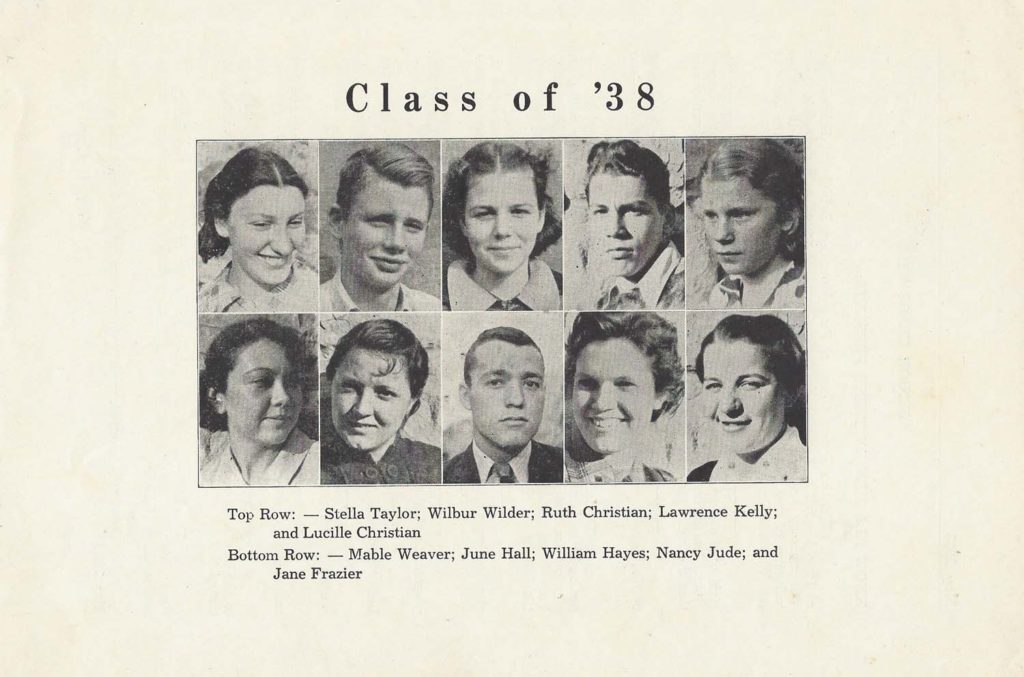
“Class of ’38.” [1938_class_pmss2.jpg]
WILLIAM HAYES (Part I): Farming at PMSS
By 1937, when Bill was in his junior year of high school with another year of study before graduation, he was appointed as a lead farmer for the School. The farm manager, Howard Burdine, who had served as Bill’s supervisor during the first three school years, left Pine Mountain to take on new responsibilities. He recommended that Bill be given the supervision of the farm program and Director Glyn Morris concurred. This early trust was consistent with much of Morris’ Deweyan educational philosophy in matching students with their interests and skills and then supporting them in their industrial training program.
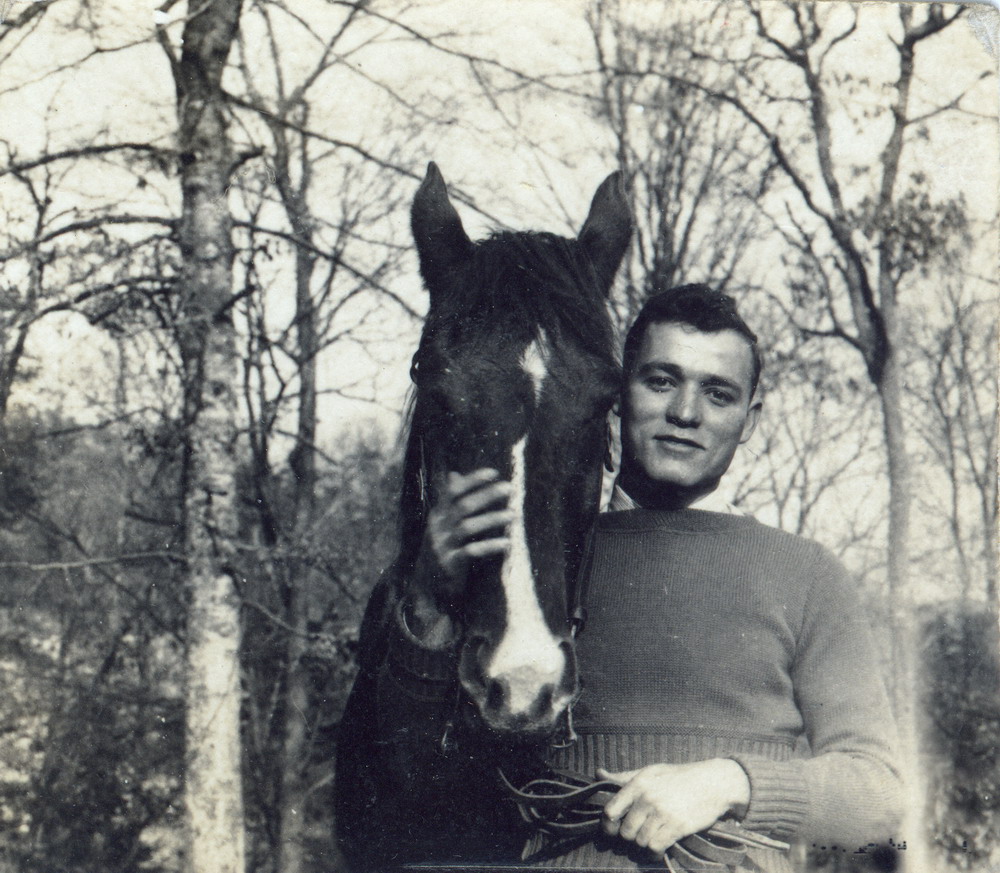
William Hayes with Sunny Jim, Pine Mountain horse, late 1930s. [dad_horse_modified.jpg]
On May 28, 1937, Arthur Dodd, the School’s Principal, wrote to Daisy Hayes regarding the progress of Bill and Paul at Pine Mountain School. He again excerpted notes from Bill’s instructors.
In appreciation and understanding of literature, [Bill’s] work has been satisfactory. He improved in grammar through the use of the new test. His studious habits of grammar as a science will bring him much gain. Because he is a boy of so observing a nature, and so sympathetic with all life about him, he has themes to write about and does so in pleasing style. For that reason he felt much in common with Lorna Doone’s writer, but there must be someone to edit the errors out of his writing. … In Social Science Bill has been the most consistent worker in the group. His accomplishment has been due to his effort. … The class appointed him chairman of the Nature Trail project and he selected the various committees, got them busy and coordinated their work….
Bill’s industrial work has continued to be of the same high caliber. He was selected, together with Clyde Blanton, to take charge of the farm this summer after Mr. Burdine leaves. This task carries with it a great deal of responsibility and we feel sure that Bill will come up to what is expected of him.
Regarding Paul’s work, Dodd quotes from his teachers:
I believe he needs only proper guidance to draw him out and he has qualities of fine sensitivity, keen observation, and good judgment. … In the boy’s cooking class he did not exert himself very much. When he did work he was very efficient and he used his tools cleverly … In discussion, he surprises us frequently with bits of knowledge which make us wonder if his inattention is merely assumed. … Paul has made a good deal of improvement this term. He is taking a more serious attitude toward life in general. I hope that you will encourage him to begin thinking about the type of work he wants to take up after he leaves school. He is getting to be quite a young man, and the sooner he makes these plans, the better.
We are saving places for both the boys next year, and will look forward to their being here.
Sincerely yours,
Arthur Dodd, Principal
The school records of the two brothers could not be more divergent, but the outcomes were remarkably consistent. Both brothers thrived on what they learned at the School, though each took his own path.
Bill’s tenure as Farm Manager at Pine Mountain Settlement was long, stretching from his junior year in high school in 1937 until he departed from the School in 1953. A description of farming at Pine Mountain School during Bill Hayes’ years is detailed in the blogs,DANCING IN THE CABBAGE PATCH V Farm and Dairy The Morris Years II and DANCING IN THE CABBAGE PATCH VI – POULTRY.
While Howard Burdine, the former Farm Manager, and Glyn Morris, the Director, were significant players in the farm education of Bill Hayes, the education was not all one direction.
!["Ayrshire Herd 1948." Barn and silo in background. [nace_II_album_041.jpg]](https://pinemountainsettlement.net/wp-content/uploads/2016/02/nace_II_album_041-866x1024.jpg)
“Ayrshire Herd 1948.” Barn and silo in background. [nace_II_album_041.jpg]
Through the nearly 20 years that Bill worked with Morris, he was constantly under Morris’s supervision. Bill had to justify his decisions, but if he made a satisfactory defense, Morris would strongly support him. It was through Morris’s appeal to the Board of Trustees that the School purchased a silo to decrease dependence on commercial feed for the growing herd of Ayrshires. It was Morris who debated with the Board the merits of White Leghorn chickens versus Rhode Island Reds at Bill’s recommendation. It was also Morris who found an old Fordson tractor and with Bill’s assistance put it to work plowing the soggy fields below Laurel House after a heavy flood had rendered the mule and plow useless. The old tractor was a critical piece of farm equipment that demonstrated the value of mechanization in the farming practice and led to the later purchases of other valuable farming equipment, and for Bill, additional experience.
What Bill gave in return was instruction in the farm program. For example, during the WWII years, Bill was instructing on changes in the government farm programs such as the Farm Defense Program. The following taken from the March 7, 1940, Pine Cone records one program:
COUNTY PLANS FARM DEFENSE PROGRAM
Special to the Pine Cone, Mr. William Hayes, Farm Supervisor
March 7, 1942
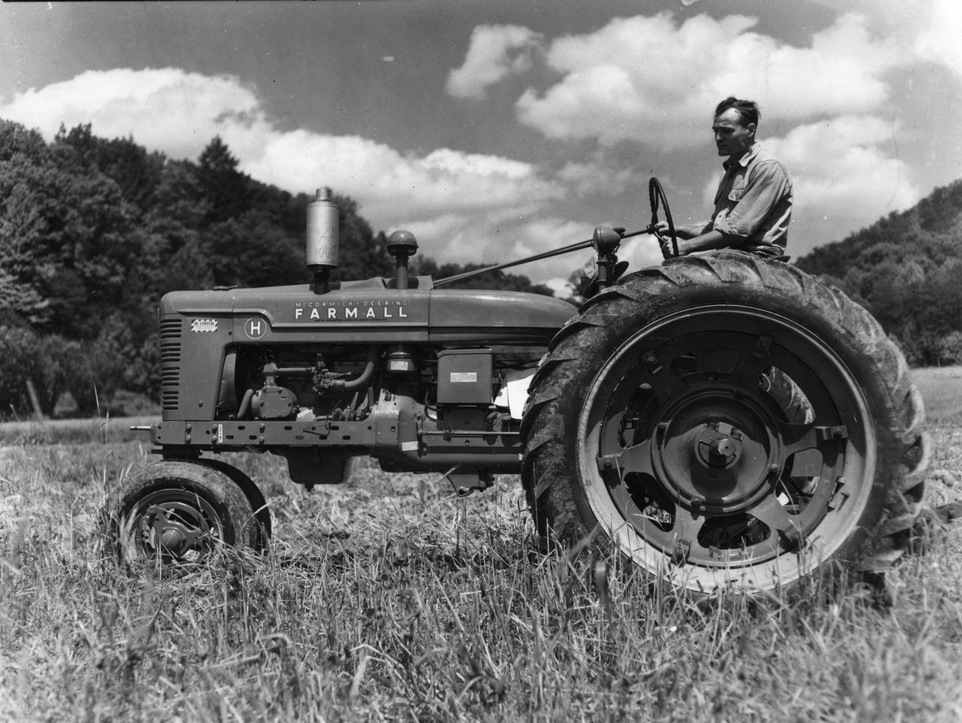
Joe Bramlett Album – Farm Manager, William Hayes, on new Farmall tractor, 1945. (Photo by Arthur Dodd) [bram_-27.jpg]
What Bill gave back to almost everyone who knew him at Pine Mountain was a sense of keen observation of the environment and a tremendous love of nature and animals. This was especially seen in his attention to the dairy herd of Ayrshires owned by the School.
THE WEDDING
The novel Lorna Doone: A Romance of Exmoor by the English author Richard Doddridge Blackmore, Bill’s English instructor whom Bill admired, must have stirred his heart. Soon after that reading, he began to court Fern Hall, a student who had accompanied the fundraising tours of 1936 and 1937 with Bill as a fellow traveler. Fern Hall had been one of the PMSS Girl’s Octet members and was a student when Bill first came to the School. A native of Perry County, Kentucky, Fern Hall, had graduated by 1937 but stayed on to work in the Office as one of the secretaries of Glyn Morris, the Director.
Fern was reading, as well. She reported in a letter in 1939 to Bill of her progress on one of the novels in the series Captain Horatio Hornblower (1939) by C. S. Forester. Apparently, there was some magic in the combination of Lorna Doone and Horatio Hornblower and Bill was ready to propose marriage. Probably Glyn Morris was reading, as well, but his choice can only be guessed. Glyn was apparently invested in the couple’s relationship,as Glyn invited himself along when Bill proposed to walk the twenty-some miles to Viper to ask Fern’s parents for permission to marry their daughter. Morris had two investments at stake. It is hard to know if he was aiming to keep his farmer or keep his secretary. He was successful in keeping both.
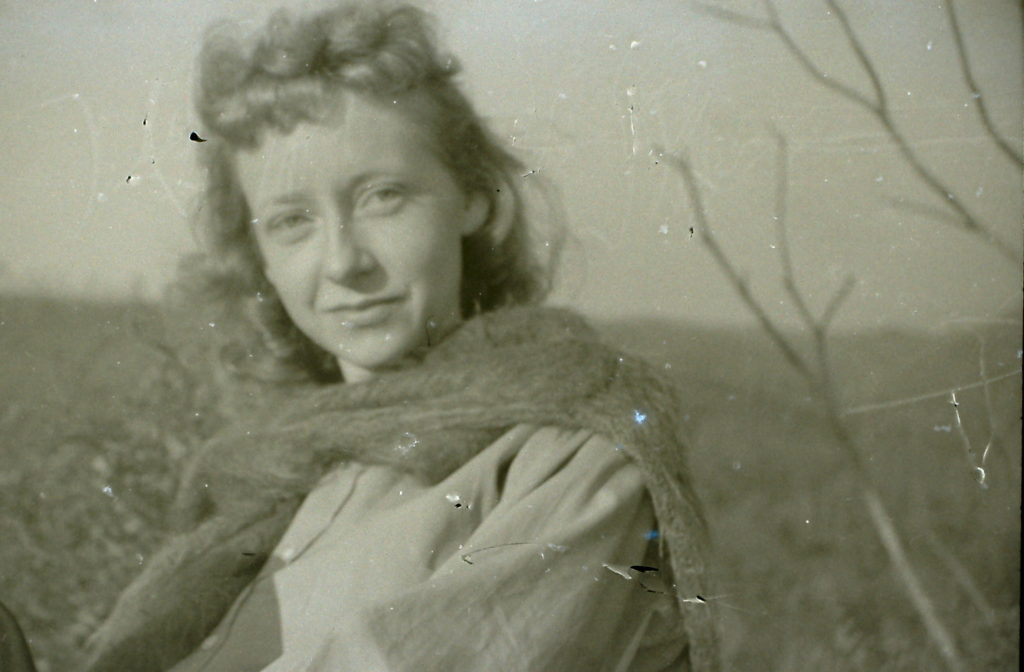
Fern Hall , c. 1940. [IMAG0128.jpg]
The account of Bill and Glyn Morris’s walk from Pine Mountain to Viper is related in Morris’ autobiography, Less Traveled Roads, and reads like an elegy to the forest and to life in the Southern Appalachians. The hike was a journey that obviously made a deep impression on Morris and Bill obviously charmed Morris and the Hall family when he made his successful “ask.”

Fern Hall’s Dance Card. [hay0135_small.jpg]
The courtship of Fern and Bill was a romantic one and the wedding of the two was remembered by many for its celebration of the traditional wedding elegance. It was a well-documented event. Married on June 6, 1940, the couple had known one another since 1934 as each grew into adulthood at the School. Morris, a minister and graduate of Union Theological Seminary who had watched them both grow and flourish, officiated at the wedding ceremony. Bill’s brothers and one of Bill’s teachers, Everett Wilson, and two other close friends were best men. Fern’s bridesmaids were her sister Pat Hall and members of the Octet group.
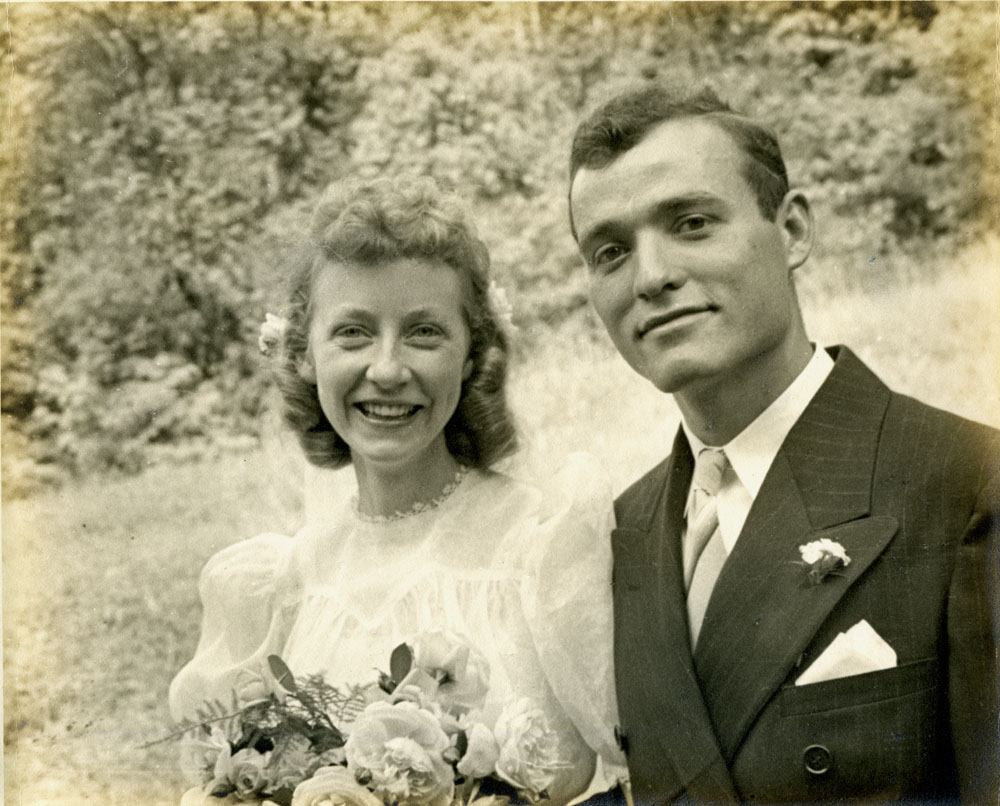
Fern Hall Hayes and William Hayes, married June 6, 1940. [hayes_001.jpg]
WILLIAM HAYES (Part I): THE WEDDING and the FUNERALS
The pastoral novel of Lorna Doone, a fast-paced story of love and revenge not unlike some of the ballads well-known to the students and staff at Pine Mountain, may have inspired Bill to add romance to his life but the wedding was not only a romantic affair but also a festive one for the campus and well attended by Bill’s and Fern’s parents, his brothers and the staff and students at Pine Mountain. It had no revenge scene, except the final toss of the groom into the cold waters of the swimming pool at the School.
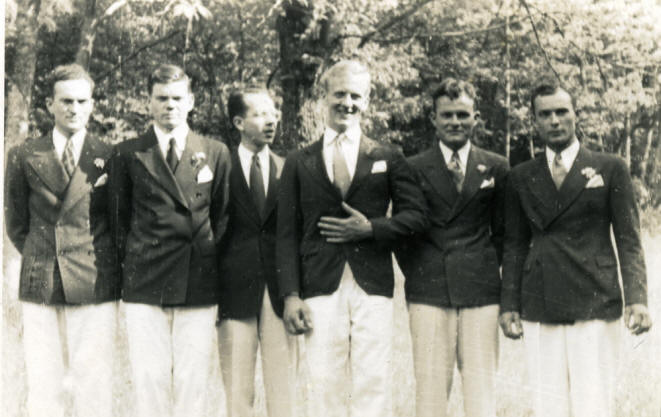
Best men at Hayes wedding, 1940. Silven Hayes, [?], Everett Wilson, [?], Paul Hayes, John Hayes. [hay0177.jpg]
The toss was a ritual for couples married at the School, including Bill’s younger brother Paul when he wed Mattie Ayers four years later. Also, William David Martin experienced the same event when he married Fern’s sister, Patsy Flora Hall, near the same time. June weddings in the Pine Mountain Chapel were often well photographed at the School and continue to be today. Many families in the area can trace their beginnings to the “wedding in the Chapel” or the participation in one.
The Chapel is also a place of closure when members of the Pine Mountain community pass away. Silven, Bill’s brother killed in action in France in WWII and a PMSS student, was remembered in the Chapel. Both Bill and Fern had memorial services in the same Chapel in which they met; in which they were married and today, where they continue to be remembered. Their son Steven, a Navy Commander and pilot was also memorialized in the Chapel after he was killed when his military plane went down on Mt. Rainier on a routine training flight in March of 1983.
WILLIAM HAYES (Part I): The Dance and the Ballgame
Dancing and softball were Bill’s other two passions. He was a quick study for many of the folk dances taught at the School during his student years and he continued to enjoy folk dancing until the end of his life. The complicated Morris (no relationship to Glyn Morris!) Dancing and Sword Dancing were of particular interest to Bill and he excelled at the dance forms and took his skills on the 1936 and 1937 fundraising tours for the School. Ultimately, he was among the PMSS students chosen to perform for President and Mrs. Roosevelt at the White House in 1937.
- Folk dancing at Pine Mountain. [III_campus_life_0774.jpg]
- William and Fern Hall Hayes, dancing. [III_campus_life_0775.jpg]
- Morris Dancing at PMSS. [III_campus_life_0777c.jpg]
- Morris Dancing at PMSS. [III_campus_life_0783.jpg]
- Sword Dancing, the forming of the star. [III_campus_life_0779a.jpg]
- May Day 1930s. William Hayes (far right), Paul Hayes (third from right, face covered), Glyn Morris (2nd from right). [burkh_004.jpg]
His ballgame was also well-practiced and he played for many years on the Pine Mountain Settlement School ball team, “The Pine Mountain Eagles,” as a student and later as a staff member.
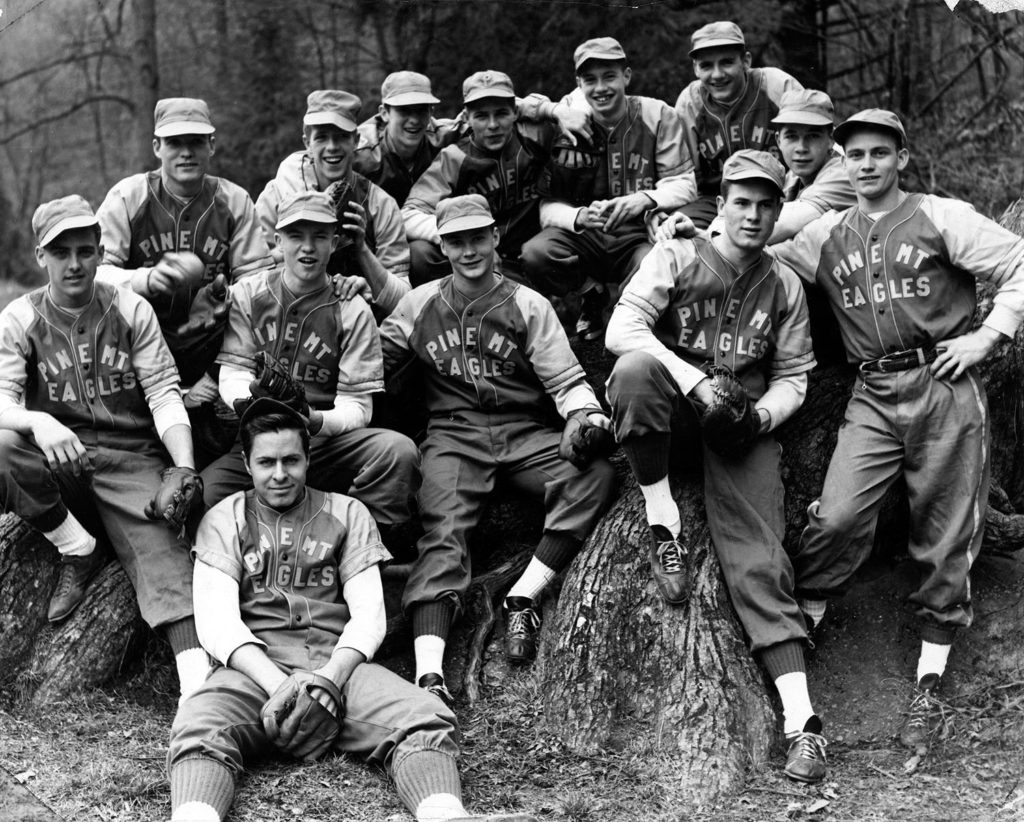
Pine Mountain Softball team, the Eagles. William Hayes, second from left, c. 1940. [ser_19_students_misc_groups_0054.jpg]
WILLIAM HAYES (Part I): Master Pastureman
As the farm became increasingly non-viable after the closure of the boarding school, Berea College suggested a re-evaluation of programs and a hard look at the farm. The extensive study completed by Fu Liang Chang, then associated with Berea College, pointed toward a difficult future for farming at the School as well as across the nation. Bill began to look toward other careers.
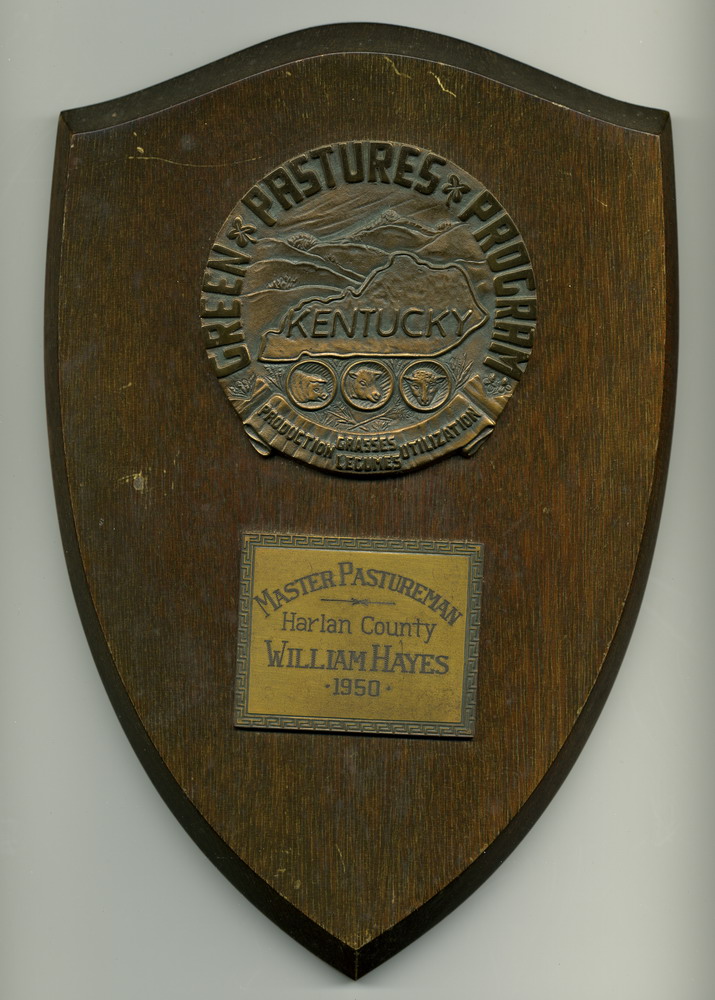
[hay0110.jpg]
The years following the closure of the boarding school were some of the finest farm years for Bill but some of the most difficult as farming faced numerous critiques by “experts” and economists. Farming throughout the country was becoming an industrial endeavor and regulations were difficult to maintain for small farming operations.
In an attempt to present the farm as a demonstration project for the community Bill turned to the Kentucky Green Pastures Program that was part of the state Agricultural Conservation Program. It was a demonstration program that promoted cultivation of pasture lands as an example of wise land use. The program was available to Kentucky farmers who filed a farm conservation plan with the state. It came with support from the state and had as its objective to convert idle so-called “wasteland” to pasture. The program also provided seed for cover crops on land long farmed with corn and tobacco and assisted farmers in soil testing and seed for ground covers such as grasses and legumes that would hold soil to steep hillsides. The conservation plan also provided guidance in the sourcing of water for pasture fields. Bill believed that he could model the best of these Green Pastures and encourage the community toward conservation of their lands.
The award of Harlan County Master Pastureman in 1950, by the Green Pastures Program of Kentucky and again in 1953, were testaments to the determined actions he took to try to find ways to maintain the farm program at the School. But, the clock had run out on small scale farming and Pine Mountain had no additional funding to invest in experimental projects nor could the community afford the growing array of expensive farm machinery.
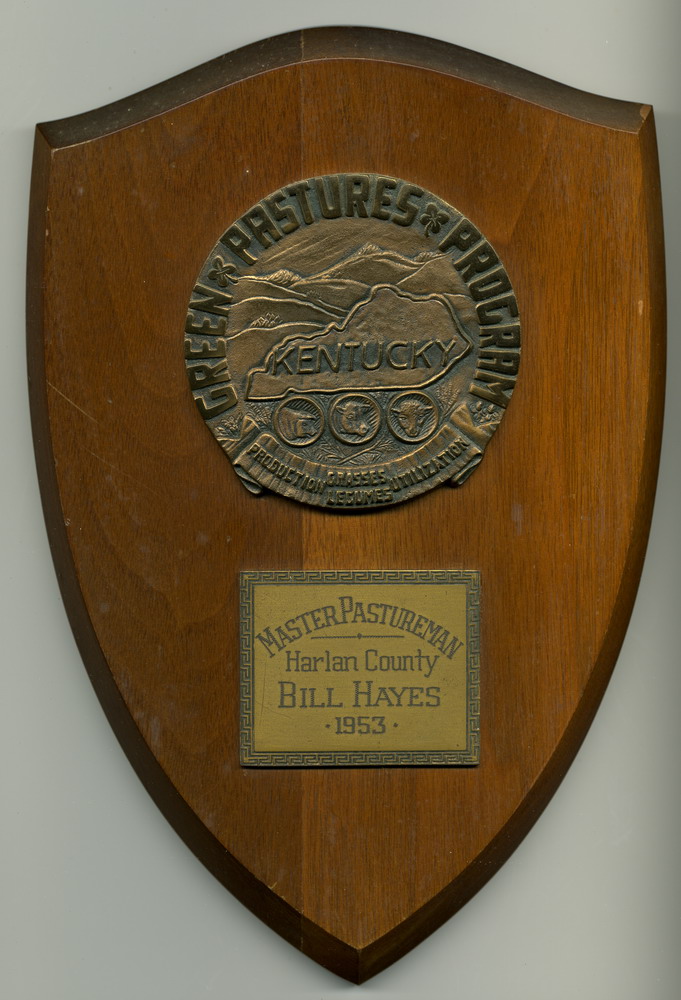
William Hayes Master Pastureman [hay0109.jpg]
Bill saw the opportunity to demonstrate how farmers could be better conservationists and had put two difficult years into his demonstrations. His was not a futile effort as some described it. What his efforts accomplished was fundamental to the national march toward agri-business and prepared him for his next career path in the fossil fuel industry. At Pine Mountain, he left many improved farm practices at the School and in the community particularly in the area of land conservation. His interest and knowledge of land conservation were essential to his later careers, especially when he was asked to undertake an evaluation of soil degradation in the States’ parks. Exploring ways to guide forests to health after devastating fires is part of the Kentucky State Forestry programs, and exploring the potential productivity of orphaned surface mining sites at the end of his career, also grew out of his earlier experience as a farmer. Surface mining was showing especially poor practice in land restoration. It was clear that poor productivity was increased with the percentage of slope — a characteristic of the typical mountain farm that had already shown very low fertility on the local steep slopes.
PMSS TEACHING AND FAIR DAY SUPERVISION
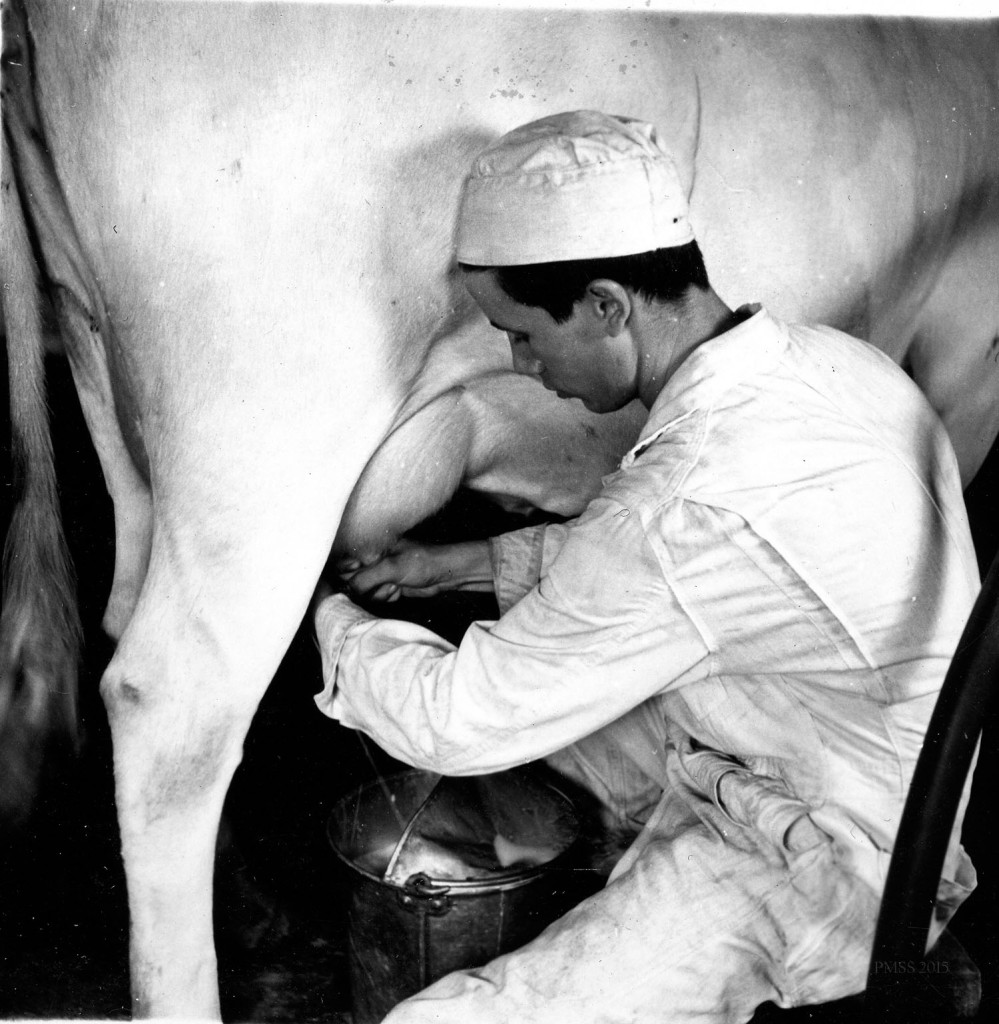
Student milking. [pm_harm_053.jg]
Teaching was the responsibility of all staff at Pine Mountain Settlement School. The Farm Manager was heavily involved in contributions to this important part of the educational program. Bill taught individuals and classes on milking cows and dairy practice, smoking meat, butchering pigs, root cellar crops, breeding animals, animal husbandry, small farm management, crop rotation, soil enhancement practice, and much more … often learning as he taught. He also went to Berea College for a brief training period early in his appointment and continued his training with the college and with the University of Kentucky demonstration center at Quicksand, KY. The most valuable instruction was, however, that he gained at Pine Mountain as a student under several very accomplished farmers.
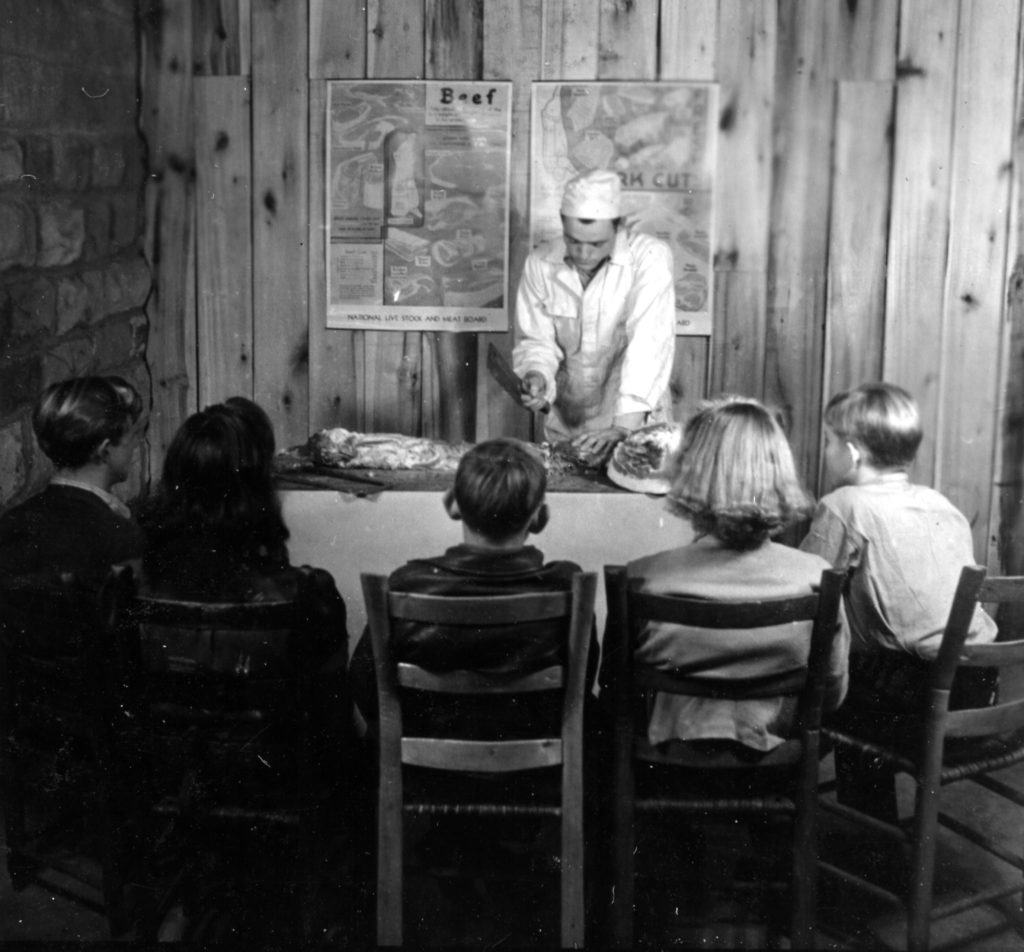
[harm_087.jpg]
In the classroom, Bill demonstrated how to prepare specific cuts of meat for students who could take those skills to markets as butchers. He explained the chemistry of a lime kiln and the necessity of vigilance in pasturing cows in fields with jimsonweed and other dangerous plants. He taught emergency veterinary practices, demonstrated proper birthing and weaning of calves and many other basic farming skills. As an instructor, he also wrote evaluations for those students who worked under his direct supervision and was sometimes placed in the awkward position of evaluating his peers, his own brother, and future brothers-in-law whom he supervised briefly on the farm crew. His evaluations were both feared and highly respected.
While the farm manager at Pine Mountain, Bill was also expected to coordinate one of the larger community gatherings at the School, the annual August FAIR DAY. [Bill’s many years of coordination of the Fair Days at Pine Mountain are covered by the pages of those annual events and also in his photographs.]
FISHING and FREEMASONRY
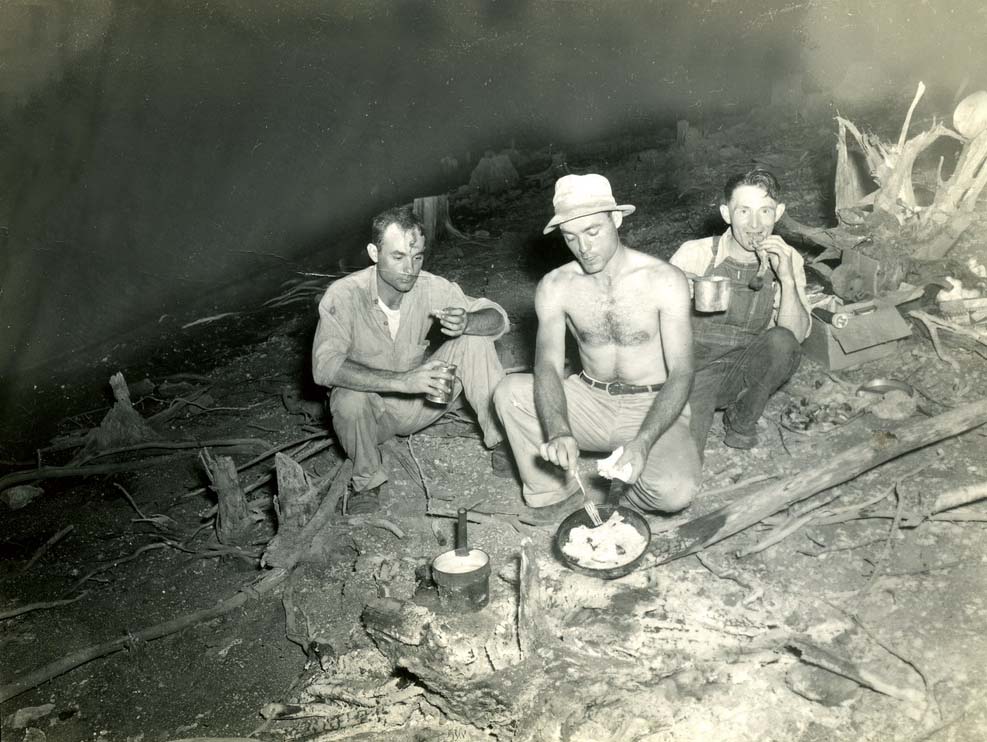
John Hayes, William Hayes, Jess Cornett, fishing trip. [hay0116.jpg]
For recreation, Bill slipped away for fishing trips with his friends and brothers and took his family on many overnight camping trips down Greasy Creek so he could get up with the fish. The newly formed TVA dams were especially enjoyed. To the left, Bill, his brother John and Jess Cornet fry fish at Norris Lake in Tennessee. Arthur Dodd, the photographer, and other PMSS staff were along for the trip.
Another diversion from the rigorous schedule at Pine Mountain was the activity of the local Masonic Lodge. Bill was a Mason for his entire adult life, as were many men in the Pine Mountain valley. He was an early member of the Nolan Lodge, No. 806, purportedly one of the oldest Lodges in Kentucky. Located close to Pine Mountain School the many members had long ties with the School, particularly the Creech family. In later years, Bill continued his membership with the Pine Mountain Nolan Masonic Lodge. Even though he lived a long distance from the Lodge he continued to pay his dues and keep in touch with many members. Freemasonry in many ways guided his ethics and integrity and strengthened his resolve during difficult times. Those very difficult times were not too far distant.
WILLIAM HAYES (Part I): Vespers
Staff at Pine Mountain Settlement School were each in turn asked to lead a Vespers at the campus chapel. In the mid-1940s Bill planned a service for the School that reflects the severe tensions brought on by a world at war. His prayer follows:
Our Father in Heaven, we bless Thee for this thoughtful time in which the delicate and more subtle things of life become more real. Let our thoughts reach out and dwell on what is good and true and lovely. Unburden our hearts of worry or care so that we may receive abundantly of what is right. To all the things we have seen or heard this day we are glad to add this thoughtful hour, and through it feel more deeply and clearly what this day has brought. Be near us and bless us through Jesus Christ our Lord. AMEN
TO SEE THE FULL SERVICE:
NEXT:
WILLIAM HAYES (Part 2)
WILLIAM HAYES (Part 3)
WILLIAM HAYES KENTUCKY GUILD OF ARTISTS & CRAFTSMEN
WILLIAM HAYES PHOTOGRAPH COLLECTION
WILLIAM HAYES NATIVE AMERICAN COLLECTION
WILLIAM HAYES PMSS School Record and Workbook
SEE ALSO:
Berea College Special Collections & Archives, “Folk Dance Interview Transcripts, SC-CT-852-008 Bill & Fern Hayes, Grazia Combs, Ruby (Hall) Brashear.” Early American Dance in Eastern Kentucky. Interviewed by Peter Rogers, July 15, 1975.
DANCING IN THE CABBAGE PATCH Farm and Dairy II Morris Years 1931-1941
DANCING IN THE CABBAGE PATCH Poultry
FARM Community Fair Day History
FERN HALL HAYES Student Staff – Biography
SEE ALSO:
Settlement Schools of Appalachia
RETURN TO:
BIOGRAPHY – A-Z
GOVERNANCE BOT Chronological Guide
GOVERNANCE BOT Alphabetical Guide to Board Members
|
Title |
William Hayes |
|
Alt. Title |
Bill Hayes |
|
Identifier |
|
|
Creator |
Pine Mountain Settlement School, Pine Mountain, KY |
|
Alt. Creator |
Ann Angel Eberhardt, Helen Hayes Wykle, |
|
Subject Keyword |
William Hayes ; Bill Hayes ; Pine Mountain Settlement School ; Fern Hall Hayes ; farm manager ; Dr. Richard Drake ; Berea College Service Award ; surface mining ; SMCRA ; Kentucky Division of Forestry ; Putney, KY ; US Forest Service ; Daniel Boone National Forest ; Red River Gorge ; Little Shepherd Trail ; forestry ; scenic roads ; Wilson Wyatt ; Office of Surface Mining ; US Department of the Interior ; reclamation ; Lands Unsuitable for Mining ; coal mining ; coal camps ; tuberculosis ; Dr. Willis Weatherford ; |
|
Subject LCSH |
Hayes, William, — September 3, 1917 – March 3, 2006. |
|
Date |
2016-05-22 |
|
Publisher |
Pine Mountain Settlement School, Pine Mountain, KY |
|
Contributor |
n/a |
|
Type |
Collections ; text ; image ; |
|
Format |
Original and copies of documents and correspondence in file folders in filing cabinet |
|
Source |
Series 09: BIOGRAPHY ; Series 19: STUDENTS ; Series 02: GOVERNANCE ; |
|
Language |
English |
|
Relation |
Is related to: |
|
Coverage Temporal |
1917 – 2006 |
|
Coverage Spatial |
Pine Mountain, KY ; Harlan County, KY ; |
|
Rights |
Any display, publication, or public use must credit the Pine Mountain Settlement School. Copyright retained by the creators of certain items in the collection, or their descendants, as stipulated by United States copyright law. |
|
Donor |
n/a |
|
Description |
Core documents, correspondence, writings, and administrative papers of William Hayes ; clippings, photographs, books by or about William Hayes ; |
|
Acquisition |
n/d |
|
Citation |
“[Identification of Item],” [Collection Name] [Series Number, if applicable]. Pine Mountain Settlement School Institutional Papers. Pine Mountain Settlement School, Pine Mountain, KY. |
|
Processed By |
Helen Hayes Wykle ; Ann Angel Eberhardt ; |
|
Last Updated |
2016-05-31 hhw ; 2016-06-16 aae ; 2016-06-29 hhw ; 2016-07-15 hhw ; 2016-10-20 hhw ; 2024-12-04 aae ; 2024-12-12 hhw ; 2025-11-08 aae ; |
|
Bibliography |
Source “Hayes, William.” Series 09: BIOGRAPHY ; Series 19: STUDENTS ; Series 02: GOVERNANCE ; Administration – Board of Trustees. Pine Mountain Settlement School Institutional Papers. Pine Mountain Settlement School, Pine Mountain, KY. Archival material. Bibliography 1963 GUIDANCE INSTITUTE REPORT (pp. 38-48) Blackmore, R D. Lorna Doon: A Romance of Exmoor. New York: The Book League of America, n.d.. Print. George, Charles, and John Fox. The Little Shepherd of Kingdom Come: A Play in Three Acts. Boston, Mass: Walter H. Baker Co., 1938. Print. VII 64 LIFE WORK – GENERAL MAINTENANCE, FARM, GROUNDS II (Berea #1943-1960) https://pinemountainsettlement.net/?page_id=34558 Accessed 2016. Morris, Glyn. Less Travelled Roads. New York: Vantage Press, 1977. Print. Pine Mountain Settlement School Notes, Pine Mountain Settlement School Conifer. Pine Mountain Settlement School Pine Cone. Reece, Erik. Lost Mountain: A Year in the Vanishing Wilderness : Radical Strip Mining and the Devastation of Appalachia. New York: Riverhead Books, 2006. Print. Surface Mining Control and Reclamation Act of 1977 – Hearing Before the Sub-Committee on Public Lands and Resources of the Committee on Energy and Natural Resources, United States Senate 95th Congress, first session on S.& a bill to provide for the cooperation between the Secretary of the Interior and the States with respect to the Regulating of Surface e iIning Operations and the Acquisition and reclamation of abandoned mining and for other purposes. |










